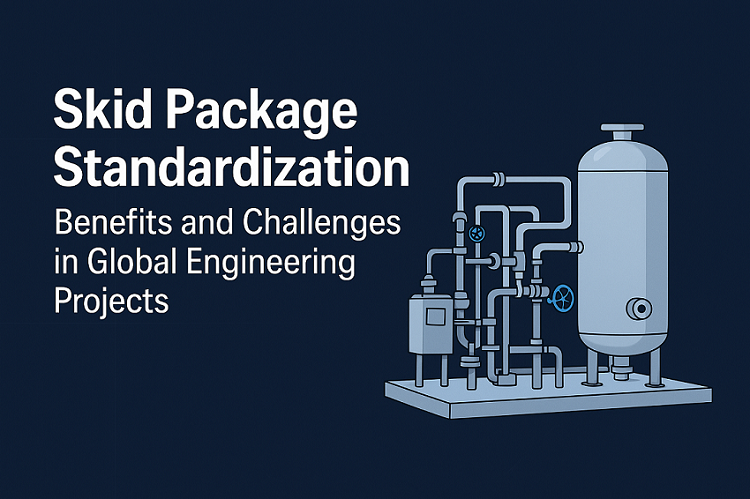
In the modern industrial landscape, efficiency, reliability, and cost-effectiveness are more important than ever. One solution that has emerged to meet these demands is the skid package—a pre-fabricated, modular unit that integrates multiple components and systems into a single, transportable framework. From oil & gas to chemical, energy, and pharmaceutical industries, skid packages have become indispensable for engineering projects worldwide.
With increasing globalization and the need to deliver projects faster, the concept of skid package standardization is gaining significant traction. Standardization ensures uniformity in design, improves operational efficiency, and provides global scalability. In this blog, we’ll explore the benefits and challenges of skid package standardization, and provide practical insights for implementing it in global engineering projects.
Understanding Skid Package Standardization
Skid package standardization refers to creating modular skid units with consistent design principles, material specifications, and construction practices across multiple projects. Unlike custom skid packages, standardized designs focus on uniformity and repeatability, which makes them easier to fabricate, transport, and install.
Key elements of standardization include:
- Design Uniformity: All units follow the same layout and engineering principles, reducing errors and rework.
- Material and Component Selection: Standardized components simplify procurement and maintenance, ensuring availability across multiple projects.
- Modular Construction Principles: Skid packages are pre-fabricated, tested, and delivered as a complete module, allowing for quick on-site assembly.
By standardizing skid packages, companies can achieve operational efficiency and cost savings, while maintaining flexibility for project-specific customization.
Benefits of Skid Package Standardization
1. Cost Efficiency
Standardized skid packages reduce engineering design hours, thanks to pre-defined templates and layouts. Procuring standardized materials and components also leads to economies of scale, lowering overall project costs. Fabrication and installation are streamlined, further saving on labor and reducing project budgets.
2. Faster Project Execution
By using standardized designs, the need for repeated design approvals is minimized. Pre-fabricated skid units allow for streamlined assembly and commissioning, while logistics and transportation are simplified, especially in large-scale or international projects. This results in faster project completion and improved timeline management.
3. Improved Quality & Reliability
Standardization ensures consistent quality control procedures, reducing errors and rework. Uniform designs and tested systems enhance reliability, safety, and operational stability. Compliance with industry standards, such as ASME, further strengthens system integrity.
4. Simplified Maintenance & Operations
Standardized skid packages make maintenance and operations easier. Spare parts are readily available, and SOPs (Standard Operating Procedures) can be applied across multiple projects. This reduces downtime and ensures consistent operational performance.
5. Global Scalability
One of the most significant advantages of standardization is replicability. Standardized skid packages can be deployed across multiple sites, ensuring global scalability. They integrate easily into international projects while adhering to global engineering standards like ASME and ISO.
Challenges of Skid Package Standardization
While the benefits are clear, standardization also comes with certain challenges:
1. Initial Investment
Developing standardized designs requires upfront engineering effort and investment. Creating modular templates and documentation can be costly but is essential for long-term efficiency.
2. Design Flexibility Constraints
Standardized skid packages may limit customization. Companies must balance uniformity with project-specific requirements to meet unique operational needs.
3. Regulatory and Compliance Issues
Standard designs must comply with local codes and regulations, which may vary across regions. Handling these variations while maintaining standardization can be challenging.
4. Integration with Existing Systems
Retrofitting standardized skid packages into existing infrastructure can be complex, especially when dealing with legacy equipment.
5. Change Management
Adopting standardization requires convincing stakeholders and training personnel. Change management is critical to ensure smooth adoption and operational success.
Case Studies / Real-World Examples
Example 1: In an oil & gas project, a company implemented standardized skid packages for multiple drilling units. The result was a 30% reduction in engineering hours and faster project delivery, saving significant costs.
Example 2: A chemical plant project faced initial challenges integrating standardized skid packages with legacy systems. By modifying templates and updating SOPs, the plant achieved improved operational reliability and reduced downtime, highlighting lessons for future projects.
Best Practices for Implementing Skid Package Standardization
- Conduct thorough upfront design and planning to ensure modularity and scalability.
- Maintain flexibility for project-specific customization while adhering to standard templates.
- Align designs with international standards like ASME and ISO.
- Use digital engineering tools such as CAD, FEA, and CFD to validate designs.
- Regularly review and update standardized designs based on lessons learned and new technologies.
Conclusion
Skid package standardization offers cost savings, faster project execution, improved quality, simplified maintenance, and global scalability. Neocent Engineering expertise and solutions can help organizations navigate challenges such as initial investment, design flexibility, regulatory compliance, and change management, ensuring a smoother and more efficient implementation.
By balancing standardization with flexibility, engineering companies can achieve significant operational efficiencies and deliver high-quality skid solutions for global projects.
FAQs
Q1. What is skid package standardization?
It’s the process of creating modular skid units with uniform designs, materials, and construction practices, making them easier to replicate across multiple projects.
Q2. How does standardization reduce project costs?
By using pre-defined templates and standardized components, companies save on design hours, bulk procurement, and streamlined fabrication.
Q3. What are the main benefits of standardized skid packages?
They offer cost efficiency, faster project execution, consistent quality, easier maintenance, and global scalability.
Q4. What challenges do companies face with skid package standardization?
Key challenges include high initial investment, limited customization flexibility, regulatory compliance differences, and integration with legacy systems.
Q5. Can standardized skid packages be adapted for local project needs?
Yes, while the core design remains standardized, they can be customized slightly to meet regional codes and project-specific requirements.

Krupal Patel
Krupal Patel is the CEO of Neocent Engineering Pvt. Ltd., Ahmedabad, specializing in advanced engineering solutions. With over 8 years of expertise in Product Design, FEA, CFD, and ASME-BPVC stress analysis, he has successfully delivered high-precision projects across pressure vessels, piping, and structural systems.
